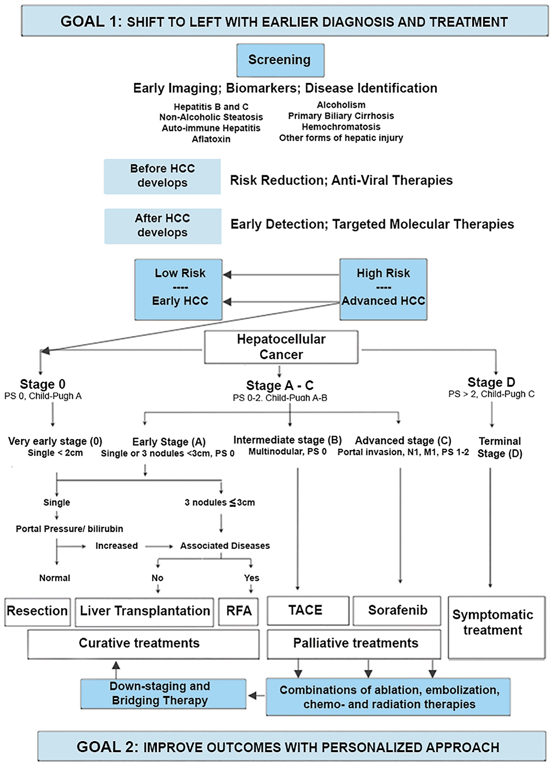Fig. 13.1
The Barcelona Clinic Liver Cancer (BCLC) staging system algorithm for Hepatocellular Carcinoma—Revised 2011 [3]
The BCLC Staging System Algorithm provides a flow chart that was designed for the staging of patients with HCC to determine the most appropriate form of therapy. In addition, we have found that the BCLC Algorithm provides an excellent platform for the development and investigation of extended treatment pathways. Ablation technologies that are currently available include radiofrequency ablation (RFA), microwave ablation (MW), cryoablation (CRYO), interstitial laser thermotherapy (ILT), and irreversible electroporation (IRE). Transarterial embolotherapy includes techniques that employ either oil-based materials or drug-eluting particles to deliver the chemotherapeutic agents (transarterial chemoembolization; TACE), as well as techniques for the catheter delivery of radiopharmaceuticles (Yttrium-90). Several different forms of radiation therapy are available as well. In addition to individual therapies, combinations of these techniques are also under investigation to control advanced disease and/or to down-stage more advanced disease so that the patient hopefully may become a candidate for a curative treatment.
The IEs identified in Chap. 12 may be used to expand and reinforce the BCLC Algorithm in several ways. Extensions may be added to the BCLC Algorithm (Fig. 13.2) that: (1) facilitate enhanced screening for HCC; (2) explore ways in which targeted therapies may be used to improve outcomes; and (3) provide statistically validated evidence regarding the selection of the best treatment from the many options available for palliative, down-staging and bridging therapies.


Fig. 13.2
It may be possible to build on the BLCL staging system algorithm with an IT system for predictive, preventive and personalized medicine (ITS-PM). The first goal will be, through enhanced screening, to have patients seek medical attention earlier in the course of their disease, so that they may enter the algorithm at a more favorable stage; i.e.—a “shift to the left”. The second goal will be to improve outcomes through a better understanding of treatment subcategories, combined treatments, and the effects of down-staging. (Modified from [2])
13.2.1 Enhanced Screening and “Shift to the Left”
It may be possible to positively influence where in the BCLC Staging System a patient enters the algorithm. It would be desirable to achieve a “shift to the left” with a greater number of patients seeking medical attention at a stage of the disease when there is a greater chance of cure. As more data are accumulated it may become possible to evaluate current screening techniques and criteria, and to improve them in light of accumulated information, with the establishment of more comprehensive programs for earlier and more effective screening.
13.2.2 Possible Expanded Role of Targeted Therapies
Currently, targeted therapies for HCC are finding applications in patients with advanced disease. However, it may also be possible to expand the role of targeted therapies in the future to influence the development or progression of disease in earlier stages. It may even become possible to shift high risk patients into low risk categories, thereby averting the development of HCC altogether.
13.2.3 Improved Outcomes with Further Personalized Approach
The BCLC Staging System Algorithm is concerned primarily with the initial treatment choices for patients with HCC. While several treatment options are indicated for patients with intermediate and advanced disease, the complexities relating to these treatment options have not yet been developed within the context of the Algorithm (although these issues are discussed with elsewhere [1–3]). The ITS-PM may be employed to generate MBME to obtain a better understanding of role of locoregional treatment options, combined treatments, and the effectiveness of down-staging and/or bridging therapies to achieve improved outcomes. The Algorithm may be expanded to include, in greater detail, the currently available treatments for HCC, individually or in combination.
Stay updated, free articles. Join our Telegram channel

Full access? Get Clinical Tree


